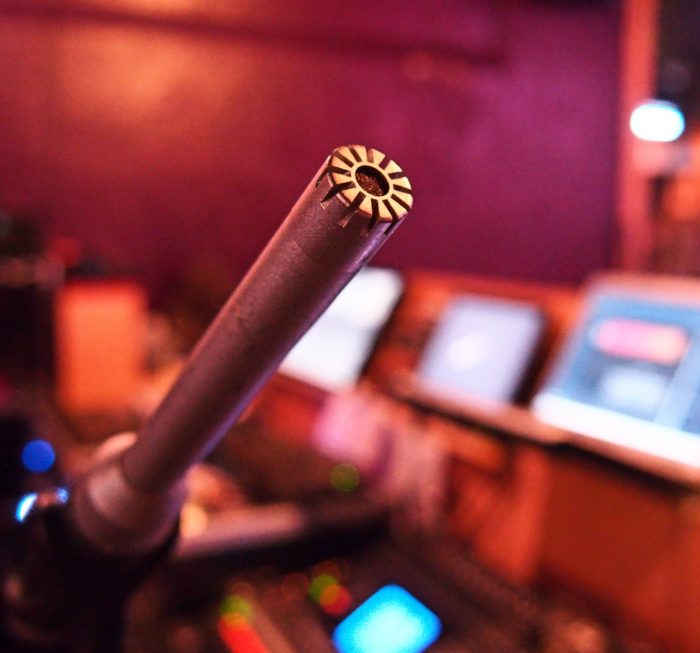I really prefer it over minutes on-end of loud pink-noise.
Please Remember:
The opinions expressed are mine only. These opinions do not necessarily reflect anybody else’s opinions. I do not own, operate, manage, or represent any band, venue, or company that I talk about, unless explicitly noted.

 Want to use this image for something else? Great! Click it for the link to a high-res or resolution-independent version.
Want to use this image for something else? Great! Click it for the link to a high-res or resolution-independent version.Today, I helped teach a live-sound class at Broadview Entertainment Arts University. We put a stage together, ran power, and set both Front Of House (FOH) and monitor-world loudspeakers. To cap-off the day, I decided to show the students a bit about measuring and tuning the boxes that we had just finished squaring away.
The software we used was Room EQ Wizard.
The more I use “REW,” the more I like the way it works. Its particular mode of operation isn’t exactly industry-standard, but I do have a tendency to ignore the trends when they aren’t really helpful or interesting to me. Rather than continually blasting pink-noise (statistically uncorrelated audio signals with equal energy per octave from 20 Hz to 20 kHz) into a room for several minutes while you tweak your EQ, Room EQ Wizard plays a predetermined sine-sweep. It then shows you a graph, you make your tweaks based on the graph, you re-measure, and iterate as many times as needed.
I prefer this workflow for more than one reason.
Single Ended Measurements Are Harder To Screw Up
The industry-standard method for measuring and tuning loudspeakers is that of the dual-FFT. If you’ve used or heard of SysTune or SMAART, among others, those are dual-FFT systems. You run an essentially arbitrary signal through your rig, with that signal not necessarily being “known” ahead of time. That signal has to be captured at two points:
1) Before it enters the signal chain you actually want to test.
2) After it exits the signal chain in question.
And, of course, you have to compensate for any propagation delay between those two points. Otherwise, your measurement will get contaminated with statistical “noise,” and become harder to read in a useful way – especially if phase matters to you. Averaging does help with this, to be fair, and I do average my “REW” curves to make them easier to parse. Anybody who has taken and examined a measurement trace in a real room knows that unsmoothed results look pretty terrifying.
In any event, dual-FFT measurements tend to be more difficult to set up and run effectively. On top of how easy it is to screw up ANY measurement, whether by measuring the wrong thing, forgetting an upstream EQ, or putting the mic in a terrible spot, you have the added hassles of getting your two measurement points routed and delay-compensated.
Over the years, dual-FFT packages have gotten much better at guiding users through the process, internally looping back the reference signal, and automatically picking compensation delay times. Even so, automating a complicated process doesn’t make the process less complicated. It just shields you from the complexity for as long as the automation can help you. (I’m not bagging on SMAART and SysTune here. They’re good bits of software that plenty of folks use successfully. I’m just pointing some things out.)
Single Ended, “Sweep” Measurements Can Be Quieter (And Less Annoying)
Another issue with measurements involving broadband signals is that they have greater susceptibility to in-room noise. As a whole, the noise may be quite loud. However, any given frequency can’t be running very “hot,” as the entire signal has to make it cleanly through the signal path. As such, noise in the room easily contaminates the test at the frequencies contained within that noise, unless you run the test signal loudly enough. With a single-ended, sine-sweep measurement, the instant that the measurement tone is at a certain frequency, the entire system output is dedicated to that frequency alone. As such, if you have in-room noise of 50 dB SPL at 1 kHz, running your measurement signal at 70 dB SPL should completely blow past the noise – while remaining comfortable to hear. With broadband noise, the measurement signal in the same situation might have to be 90 dB SPL.
Please note that single-ended measurements of broadband signals DO exist, and they have similar problems with noise as compared to broadband-noise, dual-FFT solutions.
The other nice thing about “sweep” measurements is that everybody gets a break from the noise. For 10 seconds or so, a rising tone sounds through the system, and then it stops. This is a stark contrast to minutes of “KSSSSSHHHHHH” that otherwise have to be endured.
Quality, Single Ended Measurement Software Can Be Cheaper
A person could conceivably design and build single-ended measurement software, and then sell it for a large amount of money. A person could also create dual-FFT software and give it away for free (Visual Analyzer is a good example).
However, on average, it seems that when it comes time to bring “easy to use” and “affordable” together, single-ended is where you’ll have to look. I really like Visual Analyzer, but you really, really have to know what you’re doing to use it effectively. SMAART and SysTune are user-friendly while also being incredibly powerful, but cost $700 – $1000 to acquire.
Room EQ Wizard is friendly (at least to me), and free. It’s hard to beat free when it’s also good.
I want to be careful to say (again) that I’m not trying to get people away from the highly-developed and widely accepted toolsets available in dual-FFT measurement packages. What I’m trying to say is that “dual-FFT with broadband noise in pseudo-realtime” isn’t the only way to measure and tune a sound system. There are other options that are easier to get into, and you can always step up later.